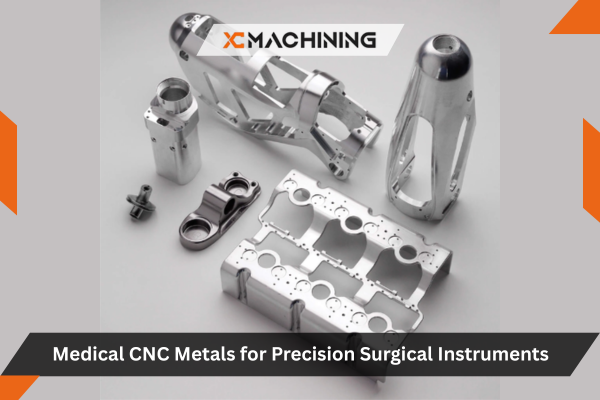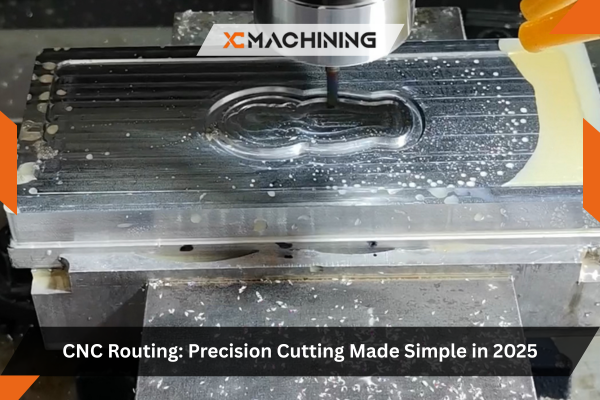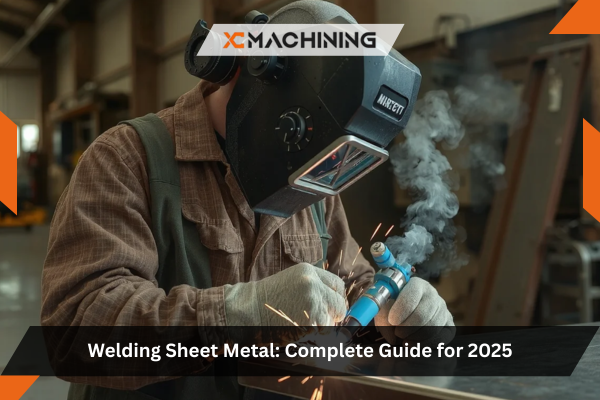The operating room represents one of the most demanding environments for manufacturing materials. When surgeons perform delicate procedures removing tumors, repairing damaged tissue, replacing diseased organs, or reconstructing anatomical structures they depend absolutely on instruments that must cut precisely, grasp securely, retract reliably, and function flawlessly through thousands of sterilization cycles. The metals comprising these surgical instruments determine whether tools perform as expected or fail at critical moments, potentially compromising patient outcomes. Medical CNC metals represent a specialized category of materials engineered specifically for biocompatibility, corrosion resistance, mechanical performance, and sterilization durability. Understanding these materials their properties, selection criteria, processing considerations, and specific applications enables medical device manufacturers, design engineers, and healthcare professionals to make informed decisions that ultimately protect patients and support surgical excellence.
The Unique Requirements of Medical CNC Metals
Materials for CNC machining in medical applications face requirements far exceeding general industrial standards. The combination of biological exposure, repeated sterilization, mechanical stresses, and life-critical function creates a demanding performance envelope that only specialized alloys satisfy.
Biocompatibility stands as the fundamental requirement for any material contacting patients. Medical CNC metals must not provoke adverse biological responses including cytotoxicity (cell death), sensitization (allergic reactions), irritation (inflammatory responses), or systemic toxicity when contacting blood, tissue, or body fluids. The ISO 10993 series establishes testing protocols verifying biocompatibility for specific contact durations and tissue types, creating the foundation for material selection in CNC machining for medical industry applications.
Corrosion resistance ensures instruments maintain integrity despite exposure to saline solutions, blood, cleaning chemicals, and sterilization processes. Surgical procedures create extremely corrosive environments—warm saline, proteins, and electrolytes combined with mechanical stress. Metals lacking adequate corrosion resistance develop pitting, crevice corrosion, or stress corrosion cracking that compromises function and potentially releases metal ions into patients.
Sterilization compatibility requires metals to withstand repeated cycles of autoclave steam (121-134°C), ethylene oxide gas, gamma radiation, or other sterilization methods without degradation, discoloration, or property changes. Reusable surgical instruments may undergo 500-1,000 or more sterilization cycles throughout their service life, making sterilization durability critical for CNC machining medical devices.
Mechanical performance demands strength, toughness, wear resistance, and fatigue endurance appropriate to each instrument’s function. Cutting instruments require hardness for edge retention. Grasping instruments need spring temper for consistent closing forces. Orthopedic instruments demand exceptional strength withstanding high mechanical loads during bone work.
Machinability affects production economics and achievable tolerances. Medical device CNC machining operations require materials that machine predictably, achieve tight tolerances, produce good surface finishes, and resist work hardening during cutting operations.
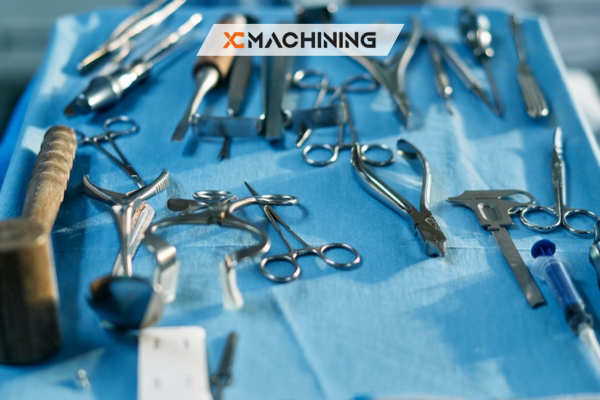
Stainless Steel Alloys: The Foundation of Surgical Instrumentation
Stainless steels dominate surgical instrument manufacturing due to their combination of corrosion resistance, biocompatibility, mechanical properties, and reasonable cost. However, “stainless steel” encompasses numerous alloys with significantly different characteristics requiring careful selection for specific applications.
316L Stainless Steel: The Biocompatible Workhorse
Type 316L stainless steel represents the most widely used medical CNC metal for general surgical instruments and medical equipment components. This austenitic stainless steel contains 16-18% chromium and 10-14% nickel providing excellent corrosion resistance through a passive chromium oxide surface layer that forms naturally in oxidizing environments.
Key properties of 316L stainless steel:
- Excellent corrosion resistance in biological environments
- Good biocompatibility for short to medium-term tissue contact
- Moderate strength (tensile strength approximately 485-690 MPa depending on condition)
- Non-magnetic properties (beneficial for MRI compatibility)
- Excellent weldability and formability
- Lower carbon content (maximum 0.03%) reducing carbide precipitation and improving corrosion resistance
Typical applications in medical CNC machining:
- General surgical instruments including forceps, clamps, and retractors
- Surgical trays and sterilization containers
- Medical equipment housings and structural components
- Orthopedic fixation devices for temporary or short-term use
- Cardiovascular stents and guidewires
- Dental instruments and temporary implants
Material cost runs approximately $3-5 per pound for bar stock, making 316L economical for high-volume instrument production. Medical CNC turning operations produce millions of surgical screws, pins, and instrument shanks annually from 316L bar stock.
420 and 440 Series Martensitic Stainless Steels: For Cutting Edges
While 316L excels in corrosion resistance and biocompatibility, its moderate hardness (typically 150-200 HB) limits ability to maintain sharp cutting edges. Surgical scissors, scalpels, and other cutting instruments require harder materials that hold edges through extended use.
Type 420 stainless steel provides an optimal balance for many surgical cutting applications:
- Hardenable through heat treatment to 50-55 HRC
- Good corrosion resistance (though inferior to 316L)
- Excellent edge retention for surgical scissors and scalpels
- Magnetic properties enable instrument retrieval if dropped
- Moderate cost and good machinability
Type 440C stainless steel offers higher hardness for the most demanding cutting applications:
- Heat treatable to 58-60 HRC providing exceptional edge retention
- Contains higher carbon (0.95-1.20%) and chromium (16-18%) than 420
- Superior wear resistance for instruments requiring maximum longevity
- Slightly reduced corrosion resistance compared to 316L or 420
- Higher material cost justified by extended service life
Applications for martensitic stainless steels:
- Surgical scissors (Mayo, Metzenbaum, dissecting scissors)
- Scalpel blades (disposable) and handles (reusable)
- Rongeurs and bone-cutting instruments
- Dental scalers and curettes
- Biopsy punches and dermatological instruments
These materials require heat treatment after machining to develop full hardness. CNC machining medical devices from martensitic stainless steels typically machines parts in annealed (soft) condition, performs heat treatment to achieve required hardness, then conducts final grinding or honing operations to achieve cutting edge geometry and surface finish.
17-4 PH Stainless Steel: Strength Through Precipitation Hardening
Type 17-4 PH (precipitation hardening) stainless steel provides exceptional strength through heat treatment after machining, making it valuable for high-stress surgical applications.
Performance characteristics:
- Extremely high strength (tensile strength 1,170-1,310 MPa in H900 condition)
- Good corrosion resistance approaching 316L
- Excellent fatigue resistance for cyclic loading applications
- Heat treatable after machining enabling tight-tolerance machining before hardening
- Moderate biocompatibility suitable for external or short-term contact applications
Medical applications:
- Orthopedic surgical instruments subjected to high forces
- Needle holders requiring spring temper and high closing forces
- Bone drills, saws, and cutting guides
- Laparoscopic instrument shafts requiring rigidity in small diameters
- Surgical power tool components
- Medical equipment structural parts requiring high strength
Material cost runs approximately $4-7 per pound, with the premium justified by superior mechanical performance enabling lighter, stronger instrument designs.
Titanium and Titanium Alloys: The Premium Choice
Titanium offers exceptional properties for specialized surgical instrument applications, though higher material costs and challenging machining characteristics limit use to applications justifying the premium.
Commercially Pure (CP) Titanium
Available in four grades (1-4) with increasing strength, CP titanium provides excellent biocompatibility and corrosion resistance for surgical applications.
Advantages for surgical instruments:
- Outstanding biocompatibility (among the best of all metals)
- Excellent corrosion resistance in all bodily environments
- Non-magnetic properties ideal for MRI compatibility
- Approximately 45% lighter than stainless steel reducing surgeon fatigue
- Naturally occurring oxide layer provides passivity without additional treatment
Limitations:
- Lower hardness (150-200 HB) unsuitable for cutting edges
- Higher material cost ($15-25 per pound)
- More challenging to machine requiring sharp tools, slower speeds, and adequate cooling
- Lower modulus of elasticity creates more springy feel than stainless steel
Surgical instrument applications:
- Microsurgical instruments where light weight reduces hand fatigue
- Retractors and spreaders for delicate tissue manipulation
- Cardiovascular and neurosurgical instruments
- Electrosurgical instruments (excellent electrical properties)
- MRI-compatible instruments
Ti-6Al-4V Titanium Alloy
This alpha-beta titanium alloy containing 6% aluminum and 4% vanadium represents the most widely used titanium alloy, offering strength approaching stainless steel while maintaining titanium’s biocompatibility advantages.
Performance profile:
- Tensile strength 900-950 MPa (comparable to high-strength stainless steels)
- Excellent strength-to-weight ratio
- Superior fatigue resistance
- Outstanding corrosion resistance
- Excellent biocompatibility for permanent implantation
Applications in surgical instrumentation:
- High-performance surgical power tool components
- Orthopedic instrument shafts requiring maximum strength at minimum weight
- Specialized trauma instruments
- Robotic surgical instrument components where weight reduction improves precision
Material cost runs $20-35 per pound with machining costs higher than stainless steel due to challenging material properties. Medical CNC turning of titanium alloys requires carbide tooling, proper cutting parameters, and flood coolant preventing heat buildup that accelerates tool wear.
Specialty Alloys for Demanding Applications
Beyond standard stainless steels and titanium, specialized alloys serve niche applications requiring unique property combinations.
Cobalt-Chrome Alloys
Cobalt-chromium alloys (typically CoCrMo) provide exceptional wear resistance and hardness for specialized surgical instruments.
Properties:
- Very high hardness (400-500 HV)
- Excellent wear resistance
- Outstanding corrosion resistance
- Good biocompatibility
- Difficult to machine
Surgical applications:
- Orthopedic rasps and files requiring abrasive surfaces
- Cutting guides for total joint replacement surgery
- Wear-resistant instrument inserts
- Specialized dental instruments
Extreme work hardening during machining requires aggressive initial cuts and sharp tooling. Material costs ($40-60 per pound) and difficult machining limit use to applications where properties justify expenses.
Tungsten Carbide
While technically a ceramic composite rather than pure metal, tungsten carbide provides inserts for needle holder jaws and surgical scissor cutting surfaces.
Advantages:
- Extreme hardness (1,500-2,000 HV)
- Exceptional wear resistance
- Maintains sharp edges through thousands of use cycles
Tungsten carbide inserts press or braze into stainless steel instrument bodies manufactured through CNC machining medical processes, combining carbide’s wear resistance with steel’s toughness and cost-effectiveness.
Aluminum Alloys
Medical-grade aluminum alloys serve non-patient-contact applications where light weight matters:
Type 6061-T6 aluminum:
- Excellent strength-to-weight ratio
- Good corrosion resistance
- Outstanding machinability
- Economical material cost
Applications:
- Medical equipment housings and enclosures
- Surgical instrument trays and cases
- Portable medical device structures
- Diagnostic equipment components
Material Selection Criteria for Surgical Instruments
Choosing appropriate materials for CNC machining medical devices requires systematic evaluation of multiple factors affecting performance, manufacturing, and economics.
Functional Requirements Analysis
Mechanical demands: Identify loads, stresses, and mechanical functions determining strength, hardness, and toughness requirements. Cutting instruments need hardness. Grasping instruments require spring temper. Orthopedic instruments demand high strength.
Tissue contact: Determine biocompatibility level required. External use allows broader material selection than mucosal membrane contact or bloodstream exposure.
Sterilization method: Identify sterilization processes instruments will undergo. Autoclave-only sterilization permits broader material choices than gamma radiation requiring enhanced oxidation resistance.
MRI compatibility: Neurosurgical and spinal instruments may require non-magnetic materials enabling use in MRI-guided procedures.
Corrosion environment: Consider exposure to specific chemicals, medications, or biological fluids that might accelerate corrosion of certain alloys.
Manufacturing Considerations
Achievable tolerances: Some alloys machine to tighter tolerances than others. Precision CNC machining services achieve ±0.0005″ tolerances routinely in 316L stainless but face challenges maintaining similar accuracy in hardened martensitic grades or titanium alloys.
Surface finish requirements: Functional surfaces may require specific roughness values. Grasping surfaces might specify 32-63 Ra for adequate friction, while bearing surfaces need 8-16 Ra minimizing wear.
Production volume: High-volume production justifies optimizing material selection for machining efficiency, while low-volume specialty instruments can utilize premium alloys if performance requires.
Heat treatment requirements: Martensitic stainless steels and precipitation hardening alloys require post-machining heat treatment adding cost and lead time but enabling specific property combinations.
Economic Factors
Material cost: Ranges from $3-5/lb for 316L stainless to $30-40/lb for titanium alloys. High-volume production amplifies material cost differences.
Machining costs: Difficult-to-machine materials like titanium or cobalt-chrome increase tool wear, require slower cutting speeds, and extend cycle times—potentially doubling machining costs versus 316L stainless.
Tool life: Abrasive materials accelerate cutting tool wear. Frequent tool changes increase operational costs and may affect dimensional consistency.
Scrap rates: Some materials machine more predictably than others. Work-hardening alloys may increase scrap during learning curves or with operator variability.
Processing Medical CNC Metals: Best Practices
Successfully machining medical CNC metals requires attention to material-specific processing parameters, tooling selections, and quality control protocols.
Tooling Selection
Carbide tooling: Essential for most stainless steels and mandatory for titanium. Carbide’s hardness maintains sharp cutting edges preventing work hardening.
Tool coatings: TiN (titanium nitride), TiCN (titanium carbonitride), or TiAlN (titanium aluminum nitride) coatings extend tool life and improve surface finish. TiAlN particularly benefits high-temperature alloys generating substantial cutting heat.
Tool geometry: Positive rake angles reduce cutting forces, particularly important for work-hardening austenitic stainless steels. Sharp cutting edges minimize heat generation in titanium machining.
Cutting Parameters
Speeds and feeds: Require careful optimization for each alloy. Excessive speeds generate heat accelerating tool wear. Inadequate feed rates cause rubbing rather than cutting, work-hardening surfaces.
Depth of cut: Deeper cuts in work-hardening materials prevent cutting at previously hardened surfaces. Titanium benefits from substantial cuts removing material efficiently.
Coolant application: Flood coolant essential for titanium machining. High-pressure through-spindle coolant improves chip evacuation and tool life in deep hole drilling.
Surface Integrity
Work hardening prevention: Sharp tools and appropriate feeds minimize surface work hardening that compromises material properties and complicates subsequent operations.
Burr minimization: Medical instruments require clean, burr-free edges. Tool condition, cutting parameters, and exit strategies all affect burr formation.
Surface finish: Functional requirements may specify particular roughness values. Multiple finish passes with reduced feed rates achieve fine finishes.
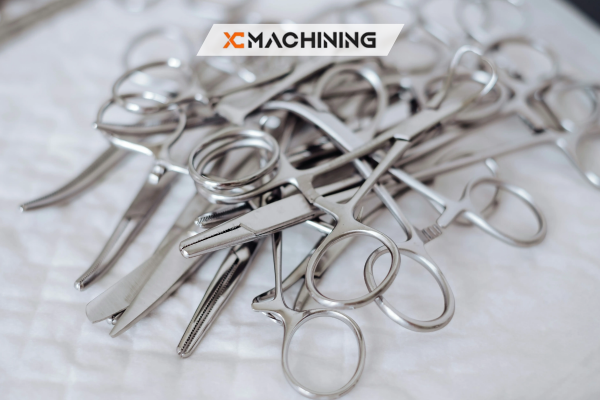
Quality Assurance
Material verification: X-ray fluorescence (XRF) or optical emission spectroscopy (OES) confirms material identity preventing mix-ups between similar-appearing alloys.
Dimensional inspection: Coordinate measuring machines (CMMs), optical comparators, and traditional metrology verify dimensional conformance.
Surface finish measurement: Profilometers quantify surface roughness ensuring compliance with functional requirements.
Hardness testing: Verifies heat treatment effectiveness for martensitic stainless steels and precipitation hardening alloys.
Regulatory and Documentation Requirements
Medical CNC metals must satisfy regulatory requirements throughout material supply chain and manufacturing processes.
Material Traceability
Mill test reports certify chemical composition and mechanical properties, tracing each material lot to original production. Medical device manufacturers maintain records linking finished instruments to specific material lots enabling recall traceability if quality issues emerge.
Biocompatibility Documentation
Material suppliers providing medical-grade stock maintain biocompatibility test data per ISO 10993, with certificates documenting testing and results for specific alloys and conditions.
Quality System Requirements
ISO 13485 certification demonstrates systematic quality management for medical device manufacturing including material handling, process control, and documentation.
Conclusion
Medical CNC metals represent specialized materials engineered to meet the extraordinary demands of surgical instrumentation biocompatibility ensuring patient safety, corrosion resistance withstanding harsh environments, mechanical performance enabling reliable function, and sterilization durability supporting reusable instrument lifecycles. From economical 316L stainless steel dominating general instrument production to premium titanium alloys serving specialized microsurgical applications, from hardened 420 stainless scissors to cobalt-chrome wear surfaces, the palette of materials for medical CNC metals machining medical devices enables instrument designs optimized for specific surgical applications.
Success requires understanding not just material properties but also processing characteristics, regulatory requirements, and economic realities. CNC machining for medical industry demands expertise spanning metallurgy, manufacturing processes, quality systems, and regulatory compliance knowledge that reputable medical device medical CNC metals machining suppliers develop through years of specialized experience. As surgical techniques advance and instruments grow increasingly sophisticated, medical CNC metals will continue evolving, enabling the next generation of surgical tools that extend and improve lives through healthcare innovation built on materials science excellence.
FAQs
Why do surgical tools rust even if they’re stainless?
Tiny surface scratches can break the chromium oxide film. A quick electropolish restores protection.
Is aluminum safe inside the body?
Pure aluminum isn’t, but anodized housing parts never touch tissue; only implants use approved alloys like titanium.
How sharp is a CNC-ground scalpel?
Edges routinely hit a 5 µm tip radius—about one-tenth the width of a human hair.
Does titanium dull faster than steel?
For cutting edges, yes; that’s why many tools pair titanium bodies with tool-steel blades.
Can recycled metal be used for surgical instruments?
Rarely. Medical specs demand virgin feedstock to avoid unknown contaminant traces.

